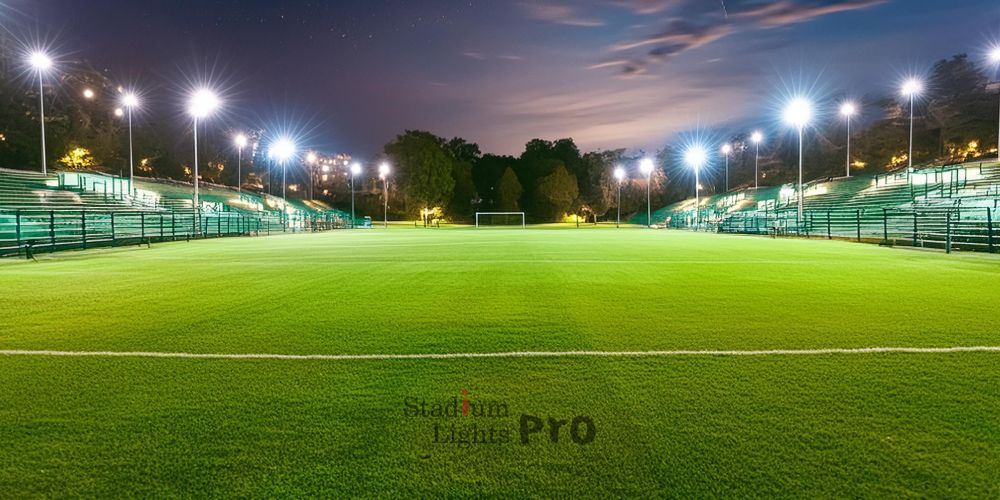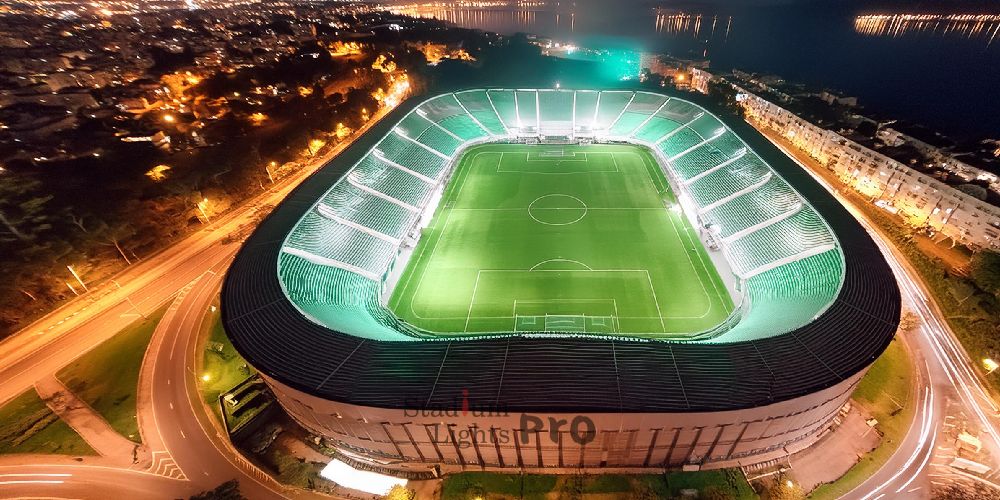One significant aspect of this endeavor is the management of stadium lighting, a critical component for both visibility and ambience during events. However, traditional lighting systems often come with substantial energy consumption, contributing to carbon emissions and escalating operational costs. Therefore, exploring eco-friendly alternatives for stadium lighting is not merely an option but a pressing necessity in aligning sports facilities with sustainable practices. Understanding the scope of energy consumption associated with stadium lighting serves as a pivotal starting point in this endeavor, providing insights into the magnitude of the challenge and the potential for impactful solutions.
Table of Contents
ToggleCurrent challenges with traditional stadium lighting
High energy consumption
Stadiums, with their vast seating capacities and extended operating hours, are notorious energy consumers, particularly concerning lighting. Conventional lighting fixtures, such as metal halide or high-pressure sodium lamps, often employed in sports arenas, demand substantial electricity to illuminate the expansive playing fields and spectator areas adequately. This high energy consumption not only results in exorbitant utility bills but also places a significant strain on local power grids, especially during peak usage periods. As a result, mitigating this energy demand is essential not only for reducing operational expenses but also for alleviating the environmental burden associated with fossil fuel-based electricity generation.
Environmental impact of conventional lighting options
The environmental repercussions of conventional stadium lighting systems extend far beyond their energy consumption. These systems typically rely on non-renewable energy sources, contributing to greenhouse gas emissions and exacerbating climate change. Moreover, the manufacturing, transportation, and disposal of traditional lighting fixtures entail substantial resource depletion and waste generation. Additionally, the heat generated by certain lighting technologies, such as incandescent bulbs, can contribute to urban heat island effects, further impacting local ecosystems and biodiversity. Therefore, the environmental impact of conventional lighting options underscores the urgent need for sustainable alternatives that prioritize resource efficiency and minimize ecological harm.
Cost implications
While conventional stadium lighting solutions may offer initial affordability in terms of equipment procurement, their long-term cost implications often outweigh the upfront savings. High energy consumption translates into hefty utility bills, imposing a considerable financial burden on stadium operators over time. Moreover, the maintenance requirements associated with traditional lighting fixtures, including bulb replacements and repair costs, can further escalate operational expenses. Additionally, fluctuations in energy prices and regulatory changes may compound these cost pressures, making it imperative for stadium owners to adopt more cost-effective and sustainable lighting solutions in the long run. By considering the holistic cost implications, including energy efficiency, maintenance savings, and regulatory compliance, stakeholders can make informed decisions that promote both fiscal responsibility and environmental stewardship.
Eco-friendly options for stadium lighting

LED lighting systems
LED lighting systems offer significant advantages in energy efficiency compared to traditional lighting technologies. LEDs consume considerably less energy to produce the same level of brightness, resulting in substantial reductions in electricity usage and associated costs for stadium operators.One of the key benefits of LED lighting is its exceptional longevity, significantly outlasting conventional lighting options such as incandescent or fluorescent bulbs. This longevity translates into reduced maintenance requirements and lower replacement costs, contributing to long-term savings for stadiums.LED technology provides stadiums with the opportunity for enhanced customization and dynamic lighting effects. With advanced control systems, operators can adjust lighting levels, colors, and patterns to create immersive experiences for spectators while optimizing energy usage based on specific event requirements.
Solar-powered lighting solutions:
Solar-powered lighting solutions harness renewable energy sources, such as sunlight, to generate electricity for stadium lighting. By utilizing solar panels installed on-site or nearby, stadiums can significantly reduce their dependence on the grid and decrease their carbon footprint.The adoption of solar-powered lighting systems allows stadiums to operate independently of traditional utility infrastructure, offering resilience against power outages and fluctuations in energy prices. This reduced reliance on the grid enhances energy security and strengthens the sustainability of stadium operations.While solar-powered lighting presents an attractive option for stadiums seeking to embrace renewable energy, considerations for installation and geographical feasibility are crucial. Factors such as available sunlight, site orientation, and shading must be carefully evaluated to ensure optimal performance and cost-effectiveness of solar installations.
Motion-sensor technology and smart lighting controls:
Motion-sensor technology and smart lighting controls enable stadiums to optimize energy usage through automated systems. By detecting occupancy levels and movement within different areas of the venue, these systems can adjust lighting levels in real-time, minimizing energy waste during periods of low activity.
The adaptability of motion-sensor technology allows stadiums to tailor lighting schedules and intensity levels to match varying occupancy levels and usage patterns throughout the day. This dynamic response not only enhances energy efficiency but also improves the overall comfort and safety of stadium environments.Integration with existing infrastructure is essential for the efficient management of motion-sensor technology and smart lighting controls in stadiums. By leveraging interconnected systems and data analytics, operators can achieve greater visibility and control over energy usage, facilitating informed decision-making and continuous optimization efforts.

Case studies and examples of eco-friendly stadium lighting implementations
Successful projects showcasing LED lighting retrofitting
Case Study
Lumina Stadium
The retrofitting of Lumina Stadium with LED lighting resulted in remarkable energy savings of up to 60% compared to the previous conventional lighting system. This project not only reduced the stadium’s carbon footprint but also significantly lowered operating costs due to decreased energy consumption and maintenance requirements.
EcoLight Arena
By upgrading to LED lighting, EcoLight Arena achieved notable improvements in lighting quality and energy efficiency. The retrofitting project not only enhanced the spectator experience but also garnered positive feedback from players and officials, highlighting the versatility and performance of LED technology in sports venues.
SolarGlow Stadium
LED lighting retrofitting at SolarGlow Stadium not only delivered substantial energy savings but also enabled the implementation of dynamic lighting effects, enhancing the venue’s visual appeal and creating immersive experiences for fans. The success of this project serves as a compelling example of the transformative potential of LED lighting in modernizing sports facilities.
Innovative applications of solar-powered lighting in sports venues
Solstice Stadium
The integration of solar-powered lighting at Solstice Stadium represents a groundbreaking approach to sustainable stadium design. By harnessing solar energy, the venue significantly reduces its environmental impact while ensuring reliable lighting for events, training sessions, and other activities.
Renewable Field
Solar-powered lighting solutions at Renewable Field demonstrate the feasibility and effectiveness of renewable energy technologies in meeting the unique lighting requirements of outdoor sports facilities. The innovative application of solar panels not only reduces operating costs but also aligns with the venue’s commitment to environmental stewardship.
Sunspark Sports Complex
Solar-powered lighting installations at Sunspark Sports Complex showcase the versatility and adaptability of renewable energy solutions in sports venues. The facility’s off-grid lighting system ensures uninterrupted operation even in remote locations, providing athletes with sustainable and reliable lighting for their training sessions.
Benefits realized through the adoption of motion-sensor technology
Energy Savings
The implementation of motion-sensor technology at stadiums has resulted in significant energy savings by automatically adjusting lighting levels based on occupancy and activity levels. This proactive approach to energy management minimizes waste and reduces utility costs for venue operators.
Enhanced Efficiency
Motion-sensor technology enhances the efficiency of stadium operations by optimizing lighting schedules and reducing unnecessary usage during idle periods. By aligning lighting with actual demand, stadiums can achieve greater resource efficiency and maximize the lifespan of lighting fixtures.
Improved Sustainability
The adoption of motion-sensor technology contributes to the overall sustainability of sports venues by reducing energy consumption and carbon emissions. This environmentally conscious approach not only benefits the bottom line but also reinforces the venue’s commitment to sustainability and responsible resource management.
Economic and environmental benefits of eco-friendly stadium lighting
Reduction in energy costs and operational expenses
LED lighting, solar-powered systems, and motion-sensor technology all contribute to significant reductions in energy consumption, leading to lower utility bills and operational expenses for stadiums.The longevity and durability of eco-friendly lighting solutions also translate into reduced maintenance costs over time, further enhancing cost-effectiveness and financial savings for venue operators.
Mitigation of carbon footprint and environmental impact
By transitioning to eco-friendly lighting options, stadiums can significantly reduce their reliance on fossil fuels and decrease greenhouse gas emissions associated with energy production.Solar-powered lighting systems utilize renewable energy sources, such as sunlight, thereby minimizing environmental harm and promoting sustainability. Motion-sensor technology ensures efficient use of resources by only activating lighting when needed, reducing unnecessary energy consumption and mitigating the environmental impact of stadium operations.
Positive branding and public perception of sustainability efforts
Investing in eco-friendly stadium lighting demonstrates a commitment to environmental stewardship and corporate social responsibility, enhancing the reputation and brand image of sports organizations and venues. Sustainable initiatives, such as LED retrofitting or solar-powered lighting installations, can generate positive publicity and engage fans, sponsors, and the community in supporting green initiatives. Demonstrating leadership in sustainability can attract environmentally conscious partners and sponsors, as well as appeal to fans who prioritize sustainability in their purchasing decisions, thus bolstering revenue streams and fostering long-term loyalty.
Challenges and considerations in transitioning to eco-friendly stadium lighting

Upfront investment and financial implications
The initial cost of implementing eco-friendly stadium lighting solutions, such as LED retrofitting or solar-powered installations, can be significant and may require substantial upfront investment.Stadium operators must carefully assess the financial implications and weigh the long-term benefits against the initial capital outlay to justify the transition to more sustainable lighting options.Financing options, such as grants, incentives, or financing programs, may be available to help offset the upfront costs and facilitate the transition to eco-friendly lighting solutions.
Technical requirements and compatibility with existing infrastructure
Transitioning to eco-friendly stadium lighting may require technical expertise and infrastructure upgrades to ensure compatibility with existing systems and facilities.Stadium operators must assess the technical requirements and feasibility of implementing LED lighting, solar-powered systems, or motion-sensor technology within their venues.Compatibility with existing lighting controls, electrical wiring, and structural considerations must be taken into account to minimize disruptions and ensure seamless integration of new lighting solutions.
Regulatory compliance and certification standards
Stadium lighting projects must comply with relevant regulations, codes, and standards governing energy efficiency, environmental impact, and safety.
Meeting regulatory requirements and obtaining necessary certifications, such as ENERGY STAR or LEED certification, may be essential for demonstrating compliance and accessing incentives or rebates.Stadium operators must stay abreast of evolving regulatory frameworks and industry standards to ensure ongoing compliance and mitigate potential risks associated with non-compliance.
Future trends and developments in sustainable stadium lighting
Advances in LED technology and efficiency improvements
Ongoing advancements in LED technology are expected to lead to further improvements in energy efficiency, luminous efficacy, and color rendering capabilities.Enhanced heat dissipation techniques, optimized chip designs, and improved manufacturing processes will contribute to increased reliability and longevity of LED lighting fixtures. Innovations such as micro-LEDs, quantum dots, and organic LEDs (OLEDs) hold promise for achieving even greater energy savings and performance enhancements in stadium lighting applications.
Integration of renewable energy sources for greater autonomy
The integration of renewable energy sources, such as solar and wind power, will play a crucial role in enhancing the sustainability and autonomy of stadium lighting systems.Hybrid lighting solutions that combine LED technology with renewable energy generation and energy storage systems (e.g., batteries) will enable stadiums to operate off-grid or reduce dependence on external power sources. Advances in energy management and grid integration technologies will facilitate seamless integration of renewable energy sources into stadium lighting infrastructure, maximizing energy efficiency and environmental benefits.
Continued innovation in smart lighting controls and automation
Smart lighting controls and automation technologies will continue to evolve, offering stadiums greater flexibility, efficiency, and customization options.
Artificial intelligence (AI) algorithms, machine learning, and predictive analytics will enable more intelligent and adaptive lighting solutions that respond dynamically to environmental conditions, user preferences, and usage patterns. Interoperability and compatibility between different smart lighting systems and IoT (Internet of Things) platforms will facilitate seamless integration with other building management systems, enhancing overall operational efficiency and performance optimization.
Conclusion
The adoption of eco-friendly stadium lighting options presents a multitude of benefits for sports venues, stakeholders, and the environment alike. From reducing energy costs and operational expenses to mitigating carbon emissions and enhancing brand reputation, sustainable lighting solutions offer a compelling value proposition for stadium operators. However, realizing these benefits requires proactive engagement and investment from stakeholders across the sports industry. By prioritizing sustainability in sports venue operations and embracing innovative technologies and practices, stakeholders can not only drive positive environmental impact but also foster a culture of responsible stewardship and leadership within the industry. Looking ahead, the future of sustainable lighting in the sports industry holds tremendous promise, with ongoing advancements in LED technology, renewable energy integration, and smart lighting controls paving the way for more efficient, resilient, and environmentally conscious sports venues worldwide.

